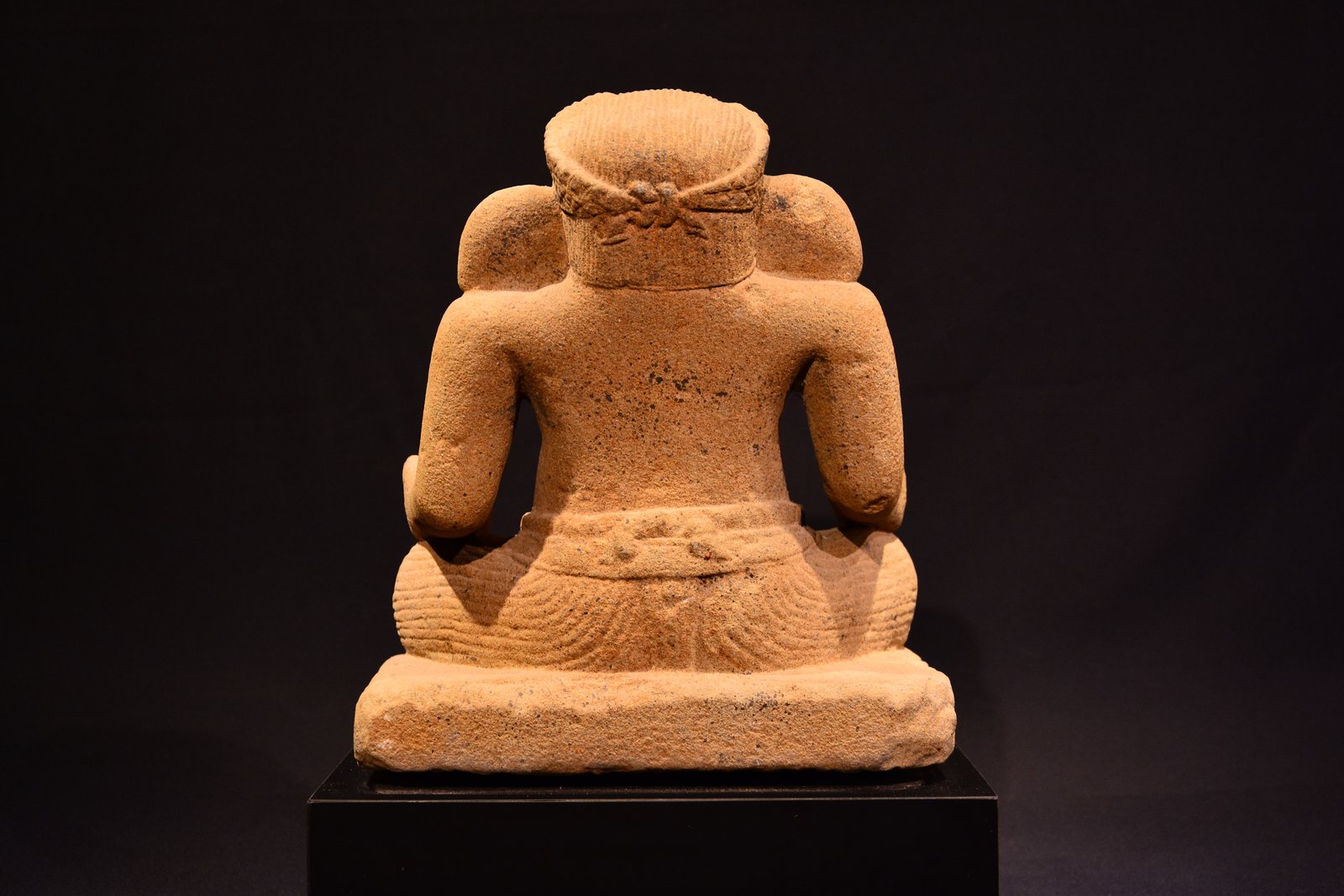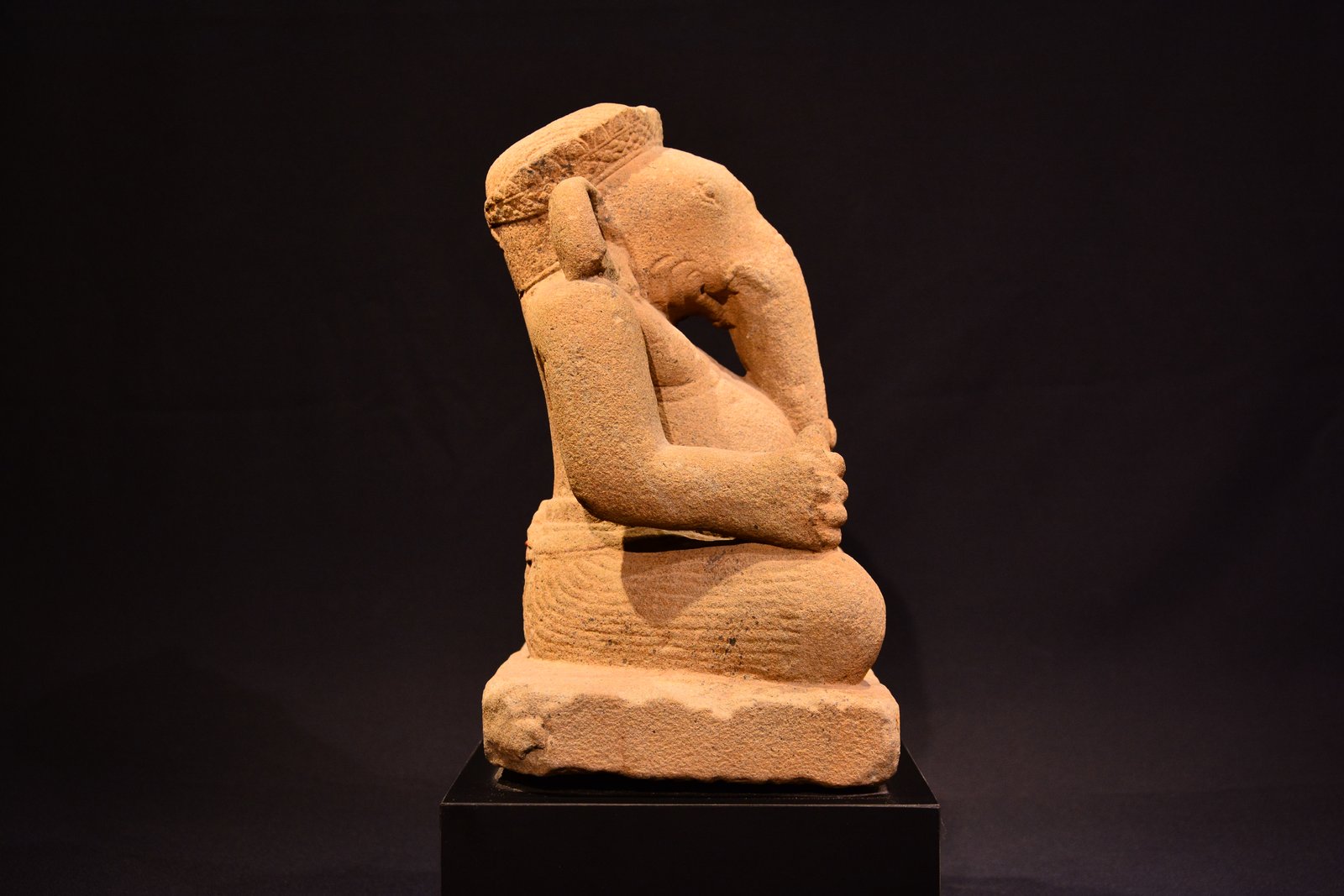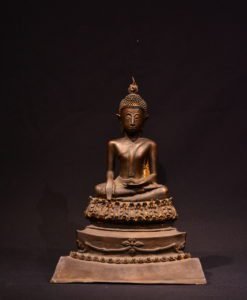Ganesha Sandstone Sculpture from the Angkor Wat Period (c. 1113–1150 CE), Cambodia – 30 cm – Humble Khmer Aesthetic in Devotional Form
This 30 cm sandstone sculpture of Ganesha from the Angkor Wat period reflects a contemplative and refined aesthetic particular to the later phase of Khmer classical art. Carved during the reign of King Suryavarman II (1113–1150 CE), this piece carries the grace of divine simplicity—embodying not only the theological importance of Ganesha in Khmer syncretic Hinduism but also the stylistic restraint that evolved within the sculptural tradition of the Angkor empire.
ITEM DESCRIPTION
Description & Iconography
Depicted in a seated posture with one leg folded downward and the other resting in a natural cross-legged fashion, Ganesha here radiates a quiet reverence. His iconic elephantine head is adorned with a Khmer royal mukuta—a headdress typically reserved for divine or noble figures. This version is partially worn, with a subtle asymmetry that echoes the passage of time and devotional handling, possibly during temple rituals or ancestral veneration.
The trunk arches downward in a gentle, naturalistic curve, resting near the right hand, which holds what appears to be a symbolic broken tusk—a classic reference to Ganesha’s sacrifice in the Mahabharata. The left hand grasps a rounded object, likely a laddu or a purna-kalasha, emphasizing abundance and the sweetness of life.
Unlike more elaborately adorned versions of Ganesha found in earlier or more courtly Khmer traditions, this piece forgoes trunk bracelets, armbands, and ornate waist decorations. Instead, its unadorned upper body and modestly rendered sampot (Khmer-style lower garment) create a visual tone of humility. This stylistic choice is consistent with certain regional or monastery-commissioned statuary, where iconographic clarity and spiritual purity were emphasized over opulence.
Stylistic Context: Angkor Wat Period Sculpture
Khmer sculpture during the Angkor Wat period is often divided into stylistic subsets based on regional workshops and evolving temple patronage. This statue represents a restrained stylistic mode, often associated with:
-
Devotional Simplicity: In contrast to the more ornamented Ganesha statues from the Baphuon or Preah Ko styles, this piece mirrors a trend where spiritual function outweighed decorative ambition.
-
Iconographic Fidelity: Despite lacking elaborate detailing, it faithfully preserves the essential symbolic attributes of Ganesha.
-
Craftsmanship in Surface Texture: The slightly coarse grain of the sandstone is characteristic of material sourced near temple complexes, where artisans skillfully worked with natural stone variations.
-
Headdress Evolution: The mukuta’s design is somewhat simplified compared to earlier depictions, indicating a shift toward symbolic abstraction and accessibility in religious representation.
Such stylistic nuances help position this sculpture within a dynamic and evolving visual language of Angkor Wat, where form and function were expertly balanced.
Physical Attributes
-
Material: Sandstone (light brown, naturally coarse grain)
-
Height: 30 cm
-
Width: 25 cm
-
Base: Integrated original stone base, free-standing
-
Condition: No restoration. Signs of wear consistent with historical digging and unearthing. A partial shift in the headdress confirms its age and authenticity.
Presence & Aura
There’s an undeniably serene aura to this sculpture. The calm eyes, modest expression, and understated posture suggest that it may have been crafted for intimate worship or regional veneration. Unlike statues made for grand shrines, this Ganesha speaks to a more personal and humble relationship with the divine—a form meant to guide, protect, and bless through inner peace, not grandeur.
Collector’s Note
Pieces like this are becoming increasingly rare. Most public and private collections favor heavily ornamented or monumental Khmer sculptures, but this understated Ganesha offers insight into the quieter, meditative side of Angkor Wat spirituality. It belongs in a collection that values not just form, but the deeper resonance of faith and regional variation within Southeast Asian religious art.
References
-
Freeman, M. & Jacques, C. (2006). Ancient Angkor. Bangkok: River Books.
-
Jessup, H.I. (2004). Art & Architecture of Cambodia. New York: Thames & Hudson.
-
Zéphir, T. (1998). Khmer: The Lost Empire of Cambodia. London: Thames & Hudson.
-
Coedes, G. (1968). The Indianized States of Southeast Asia. University of Hawaii Press.
Origin: Cambodia
Period: Angkor Wat
PRODUCT DETAIL
Medium: Sandstone
Dimensions:
Height 30 cm
Length – cm
Wide 25 cm
Condition Report: –
Please keep in touch for Price and more information: Mallika1013@gmail.com

























